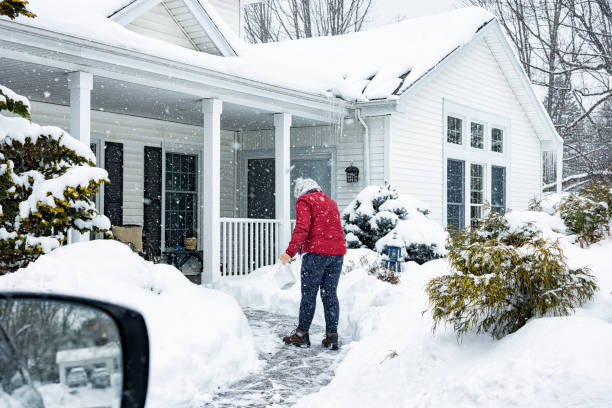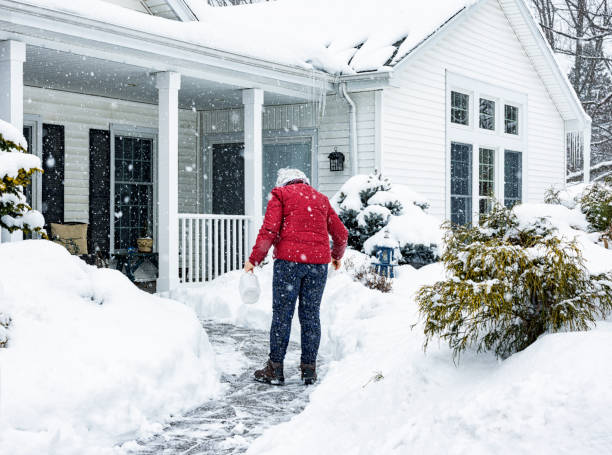Snow removal in front of your house is more than just a seasonal chore—it’s an essential responsibility that ensures safety, maintains curb appeal, and prevents long-term damage to your property. Proper snow removal also contributes to community well-being by reducing the risk of slips, falls, and accidents on walkways, driveways, and entrances. Whether you’re using shovels, snow blowers, or hiring professionals, having a solid snow removal strategy is key to navigating the winter months with ease.
This article covers everything you need to know about snow removal in front of your house, including why it’s important, best practices, tools and equipment, eco-friendly methods, and tips for making the process more efficient.



1. Why Snow Removal Is Important
a. Safety First
The most critical reason for removing snow from the front of your house is safety. Ice and snow buildup can make walkways and driveways dangerously slippery, leading to slips, falls, and other accidents. In colder climates where snow is common, unmaintained sidewalks can pose significant hazards to pedestrians, delivery personnel, and visitors.
- Slip and Fall Prevention: Accumulated snow and ice increase the risk of injuries. Clearing snow promptly minimizes these hazards, making it safer for family members, neighbors, and passersby to walk across your property.
- Vehicle Safety: A snow-covered driveway makes it challenging to drive in and out safely. Removing snow ensures better traction and visibility, reducing the risk of accidents when backing out or parking.
b. Legal Obligations
In many cities and municipalities, homeowners are required by law to remove snow from sidewalks and driveways within a specific timeframe after snowfall. Failing to do so may result in fines or liability in the event of an accident.
- Local Ordinances: Many local laws mandate snow removal within 24 hours of snowfall. It’s important to familiarize yourself with your town or city’s regulations to avoid penalties.
- Liability Concerns: If someone slips and falls on your snow-covered walkway, you could be held liable for their injuries. Removing snow and ice promptly reduces the likelihood of accidents and potential legal claims.
c. Preventing Damage to Property
Allowing snow to accumulate can cause long-term damage to your property. Water from melting snow can seep into cracks in your driveway, sidewalk, or home foundation, leading to structural damage when it refreezes.
- Driveway and Sidewalk Deterioration: When snow melts and refreezes, it expands, causing cracks to widen in concrete or asphalt. Over time, this can lead to significant damage, necessitating costly repairs.
- Water Damage: If snow is not properly removed and water isn’t directed away from the house, it can seep into the foundation or basement, causing leaks, mold, or mildew.
2. Tools and Equipment for Snow Removal
When it comes to snow removal, having the right tools can make the job quicker, easier, and more effective. Depending on the size of your property and the amount of snowfall, you may need a combination of tools to keep your driveway and walkways clear.
a. Snow Shovels
Snow shovels are the most basic and widely used tool for snow removal. They come in various designs, sizes, and materials, each suited for different types of snow and conditions.
- Ergonomic Shovels: These shovels are designed to reduce strain on the back and shoulders. They typically feature a curved handle or adjustable height to help maintain a natural posture during snow removal.
- Snow Pushers: These are wider shovels with flat blades, ideal for pushing light, fluffy snow off surfaces without lifting it.
- Heavy-Duty Shovels: For heavier, wet snow or ice, a sturdy, metal-blade shovel is often the best choice. These shovels can cut through compacted snow or ice more effectively.
b. Snow Blowers
For larger areas or significant snowfall, a snow blower can save considerable time and effort. Snow blowers come in different sizes and power levels, so it’s essential to choose the right one for your needs.
- Single-Stage Snow Blowers: These are suitable for light to moderate snowfall and work best on flat surfaces like small driveways or sidewalks. Single-stage blowers are typically lightweight and easy to maneuver.
- Two-Stage Snow Blowers: For heavier snowfalls or uneven terrain, a two-stage snow blower is a better option. These machines can handle wet, heavy snow and are more powerful, allowing you to clear larger areas more efficiently.
- Electric vs. Gas-Powered: Electric snow blowers are more eco-friendly and quieter but may not have the power of gas-powered models, which are better suited for large driveways or areas with frequent heavy snowfalls.
c. Ice Melt and Sand
Ice melt and sand are essential for keeping surfaces safe after snow removal. They help prevent ice buildup and provide traction on slippery surfaces.
- Salt-Based Ice Melt: Traditional ice melt products, like rock salt, lower the freezing point of water, causing ice to melt. However, they can be harsh on plants, concrete, and metal, so it’s important to use them sparingly.
- Eco-Friendly Ice Melt: Many homeowners prefer environmentally friendly alternatives, such as calcium magnesium acetate, which are less harmful to pets, plants, and the environment.
- Sand: Sand doesn’t melt ice, but it provides traction, making it easier to walk or drive on icy surfaces. It’s a good option for areas where you want to avoid the damage that salt can cause.
3. Best Practices for Snow Removal
Removing snow is not just about grabbing a shovel and getting to work. Following a few best practices can help you remove snow more efficiently and safely.
a. Clear Snow Early and Often
One of the most effective ways to manage snow buildup is to remove it early and often, especially during heavy snowfalls. Waiting too long can make the snow more compact and difficult to remove.
- Start Early: Begin shoveling or blowing snow while it’s still light and fluffy. This is easier on your body and prevents the snow from becoming packed down by footsteps or vehicles.
- Multiple Passes: For heavy snowstorms, don’t wait until the snow stops falling to begin clearing. Make multiple passes with the snow blower or shovel throughout the storm to keep the task manageable.
b. Shoveling Techniques
Shoveling snow can be physically demanding, so it’s important to use proper techniques to prevent injury.
- Lift with Your Legs: When lifting heavy snow, bend at the knees, not the waist, and use your legs to lift rather than your back.
- Push, Don’t Lift: Whenever possible, push the snow to the side rather than lifting it. This reduces strain on your back and shoulders.
- Take Breaks: Snow removal is a strenuous activity, so take regular breaks, especially if you’re shoveling for an extended period. Stay hydrated and don’t overexert yourself.
c. Clear All Key Areas
When removing snow, prioritize clearing key areas around your home, such as:
- Walkways and Entrances: Ensure all paths to the front and back doors are clear. Don’t forget to shovel steps and porches as well.
- Driveways: Remove snow from the entire driveway, paying special attention to the edges where snow can accumulate in large piles.
- Mailbox Area: Clear snow around your mailbox to ensure mail delivery and avoid mail carriers having to navigate icy surfaces.
d. Use Ice Melt Properly
Ice melt should be applied after snow removal to prevent ice buildup. Follow the manufacturer’s guidelines for application, as overuse can damage surfaces and harm plants.
- Pre-Treat Before Snow: Apply ice melt before the snow begins to fall to make removal easier and prevent ice from bonding to the surface.
- Avoid Over-Application: More is not always better when it comes to ice melt. Apply it sparingly to avoid damaging concrete, plants, and nearby waterways.
4. Eco-Friendly Snow Removal Practices
While snow removal is necessary, some methods can have negative environmental impacts, such as harming plants or polluting waterways. Fortunately, there are eco-friendly alternatives to help reduce your environmental footprint.
a. Use Eco-Friendly Ice Melt
As mentioned earlier, calcium magnesium acetate is a more environmentally friendly alternative to traditional rock salt. It’s less corrosive and doesn’t pose as much risk to pets or plants.
b. Shovel More, Use Less Salt
Shoveling frequently can reduce the need for chemical de-icers, minimizing your environmental impact. By clearing snow early and often, you can prevent ice from forming in the first place, reducing your reliance on salt.
c. Collect and Reuse Snowmelt
If possible, direct snowmelt to areas of your garden or lawn where it can soak into the ground and benefit plants. This reduces water waste and helps keep your property hydrated during the winter.
5. Hiring Professional Snow Removal Services
If snow removal becomes too time-consuming or physically demanding, hiring a professional snow removal service may be the best option. Professionals have the equipment and expertise to handle heavy snowfalls efficiently, allowing you to avoid the stress and effort.
- Cost Considerations: The cost of professional snow removal can vary depending on the size of your property and the frequency of service. Some companies offer seasonal contracts, while others charge per visit.
- Choosing a Service: When selecting a snow removal service, ensure they are licensed, insured, and have a good reputation. Ask for references and check reviews to find a reliable provider.
Conclusion
Snow removal in front of your house is an essential task that requires planning, effort, and the right tools. By following best practices, using proper techniques, and staying consistent throughout the winter, you can ensure safety, maintain your property, and enjoy a hassle-free winter season. Whether you handle snow removal yourself or hire professionals, being prepared is key to surviving winter snowstorms with ease.







